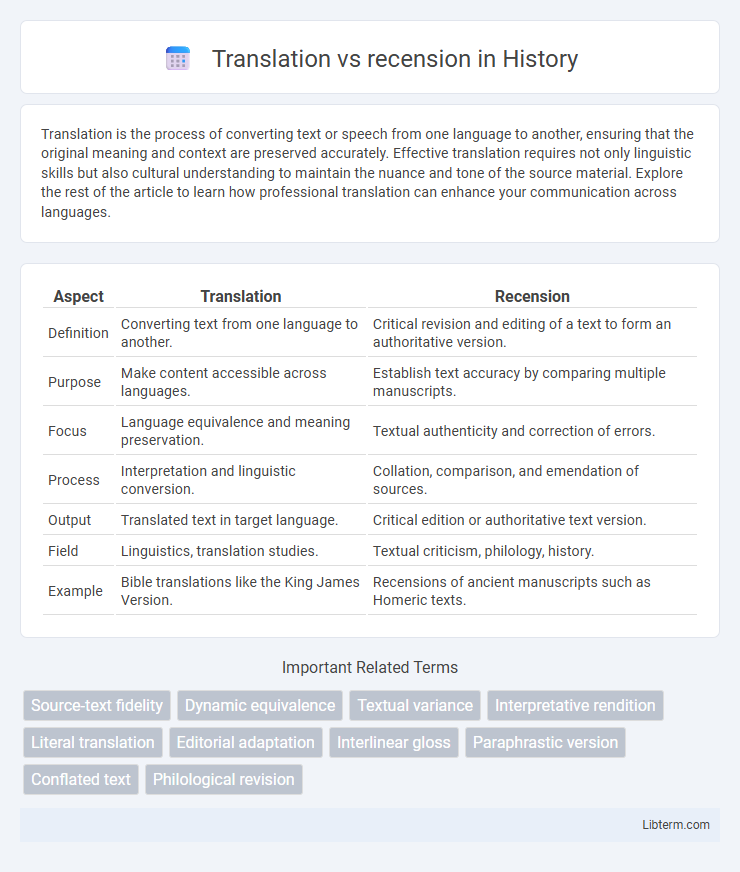Translation is the process of converting text or speech from one language to another, ensuring that the original meaning and context are preserved accurately. Effective translation requires not only linguistic skills but also cultural understanding to maintain the nuance and tone of the source material. Explore the rest of the article to learn how professional translation can enhance your communication across languages.
Table of Comparison
| Aspect | Translation | Recension |
|---|---|---|
| Definition | Converting text from one language to another. | Critical revision and editing of a text to form an authoritative version. |
| Purpose | Make content accessible across languages. | Establish text accuracy by comparing multiple manuscripts. |
| Focus | Language equivalence and meaning preservation. | Textual authenticity and correction of errors. |
| Process | Interpretation and linguistic conversion. | Collation, comparison, and emendation of sources. |
| Output | Translated text in target language. | Critical edition or authoritative text version. |
| Field | Linguistics, translation studies. | Textual criticism, philology, history. |
| Example | Bible translations like the King James Version. | Recensions of ancient manuscripts such as Homeric texts. |
Introduction to Translation and Recension
Translation involves converting text from one language into another while preserving meaning, tone, and context to ensure accurate communication across cultures. Recension focuses on critically editing or revising a text within the same language, often to correct errors, improve clarity, or restore original content based on manuscript comparison. Understanding both processes highlights the importance of linguistic fidelity and textual integrity in maintaining the authenticity of written works.
Defining Translation
Translation involves rendering text or speech from one language into another while preserving the original meaning, tone, and context, ensuring effective communication across linguistic boundaries. It requires a deep understanding of both source and target languages, encompassing cultural nuances and idiomatic expressions to maintain fidelity and clarity. Unlike recension, which refers to the critical revision and editing of a manuscript or text to establish an authoritative version, translation centers on linguistic transformation rather than textual alteration.
Understanding Recension
Recension involves critically evaluating, comparing, and revising various manuscript versions to produce a definitive text, distinct from mere translation which converts text from one language to another. Understanding recension requires recognizing its role in textual criticism, where scholars analyze variant readings to restore original content and correct errors introduced over time. This process is essential for establishing authoritative editions of historical, religious, or literary works by reconciling discrepancies found in divergent manuscripts.
Key Differences Between Translation and Recension
Translation involves converting text from one language to another while preserving the original meaning and intent, emphasizing linguistic accuracy and cultural relevance. Recension refers to the critical revision and editing of a text, often to establish an authoritative version by comparing multiple manuscripts or sources. The key difference lies in translation focusing on language transfer, whereas recension centers on textual refinement and restoration.
Historical Context of Translations
Translation and recension represent distinct processes in the historical context of translations, with translation focusing on rendering text from one language to another, while recension involves revising or editing a text within the same language to preserve or restore its original meaning. Ancient translators like St. Jerome engaged in translation to make sacred texts accessible across linguistic boundaries, whereas scholars performing recension, such as those in the Alexandrian Library, aimed to correct and standardize manuscripts. The historical context highlights how translation facilitated cross-cultural communication, whereas recension ensured textual fidelity and consistency over time.
The Role of Recensions in Textual Transmission
Recensions play a critical role in textual transmission by serving as curated revisions or edited versions of original texts, often reflecting cultural or theological nuances of a specific community. Unlike translations that convert text from one language to another, recensions involve internal transformations within the same language, preserving core meanings while adapting content for contemporary relevance or doctrinal accuracy. This process ensures the survival and continuity of texts, allowing scholars to trace variations and understand historical contexts influencing manuscript traditions.
Methods and Approaches in Translation
Translation methods involve directly converting text from a source language to a target language, emphasizing equivalence in meaning, style, and cultural context to ensure accurate communication. Approaches in translation range from literal translation, which closely follows the original text, to dynamic equivalence, focusing on conveying the intended effect and naturalness in the target language. In contrast, recension refers to the critical revision or editing of a text, often involving the comparison of multiple versions to establish an authoritative edition, which is a scholarly approach rather than a translation technique.
Techniques Used in Recension
Recension techniques focus on critical comparison and systematic revision of manuscript variants to restore the original text's authenticity. Scholars analyze textual discrepancies, collate multiple sources, and apply emendation methods to correct errors or interpolate missing content. This rigorous process ensures a refined edition that reflects the most accurate and authoritative version of the work.
Impact of Translation and Recension on Text Authenticity
Translation transforms a text from one language to another, potentially altering nuances and cultural context, which can impact the perceived authenticity and meaning of the original work. Recension involves critical editing or revising of a text within the same language, aiming to restore or preserve the original content and correct errors, thereby maintaining textual integrity. Both processes influence text authenticity differently: translation navigates linguistic and cultural boundaries, while recension focuses on fidelity to the original manuscript.
Conclusion: Choosing Between Translation and Recension
Choosing between translation and recension depends on the primary goal: to convey meaning across languages or to refine and preserve the original text's content within the same language. Translation prioritizes semantic accuracy and cultural adaptation, ensuring accessibility for a new audience, while recension focuses on textual clarity, consistency, and critical appraisal in scholarly contexts. Evaluating the intended purpose and audience determines whether translation or recension provides the optimal approach to preserving and communicating textual integrity.
Translation Infographic

 libterm.com
libterm.com